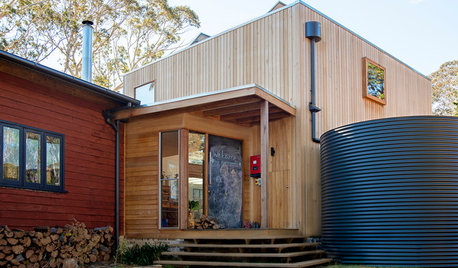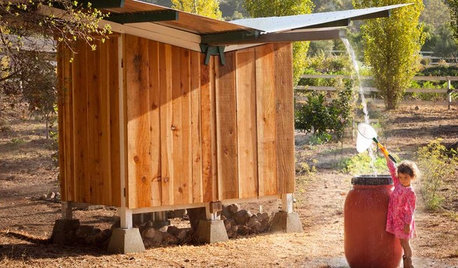Rainwater Harvesting
Redthistle
15 years ago
Related Stories

GREEN BUILDINGHow to Harvest Rainwater for Your Garden
Conserve a vital resource and save money by collecting stormwater for irrigation in a barrel or tank
Full Story
SAVING WATER6 Reasons Why You Should Save Your Rainwater Now
Collect and store during the rainy season so you’ll have water ready for irrigation when you need it
Full Story
SAVING WATERIs a Rainwater Cistern Right for You?
These extra-large containers reduce runoff and save on the use of potable water for the landscape
Full Story
FARM YOUR YARDCollecting Rainwater and Eggs From a California Chicken Coop
See how a butterfly roof helps a hen home’s design soar into double-duty territory
Full Story
GREEN BUILDINGJust Add Water: Rain Barrel Magic
Take your rainwater storage from practical to beautiful with a new breed of design-friendly rain barrels
Full Story
HOUZZ TVHouzz TV: How to Install a Rain Barrel
This DIY tutorial shows how easy it can be to capture rainwater from your roof to use in your garden later
Full Story
EARTH DAY5 Ideas for a More Earth-Friendly Garden
Consider increasing the size of garden beds, filtering rainwater and using plants to reduce energy use
Full Story
HOUZZ TOURSHouzz Tour: A Seattle Home Reaches for High Sustainability
Tapping into rainwater, sunlight and natural ventilation, a Washington state home gets both green cred and a gorgeous look
Full Story
BARN HOMESHouzz Tour: An Energy-Efficient Barn Graces the Nebraska Landscape
Passive-house technologies and a rain-harvesting and greywater system conserve natural resources in this weekend country home
Full Story
GREEN BUILDINGModern Design Captures Valuable Rain
Instead of letting a precious natural resource trickle away, these architectural features make the most of it
Full StorySponsored






Belgianpup
RedthistleOriginal Author
Related Professionals
Summit Landscape Architects & Landscape Designers · Woodinville Landscape Architects & Landscape Designers · White Oak Landscape Architects & Landscape Designers · Nashua Landscape Contractors · Northbridge Landscape Contractors · Pahrump Landscape Contractors · Spring Landscape Contractors · Yukon Landscape Contractors · Lauderdale Lakes Landscape Contractors · Boston Siding & Exteriors · Callaway Siding & Exteriors · Lafayette Siding & Exteriors · Wasco Solar Energy Systems · Alum Rock Solar Energy Systems · Rosamond Solar Energy Systemsgweirdo
RedthistleOriginal Author
gardenlen
gjcore
Belgianpup
gardenlen
rockguy
coffeehaus
gardenlen
coffeehaus
justin_berkeysupply_com
Gardeners-Watertanks